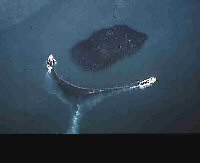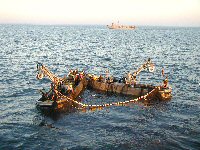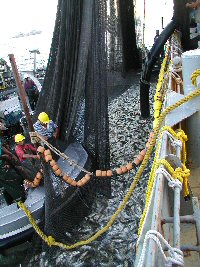Texas Gulf of Mexico Menhaden Fishery
Jerry Mambretti, Ecosystem Leader, Sabine Lake
In addition to the popular shrimp, crab, oyster and finfish fisheries, Texas' upper coast also supports an economically important gulf menhaden fishery. The purse seine fishery for gulf menhaden dates from the late 1800s. Menhaden landings in the Gulf of Mexico were sporadic and insignificant prior to World War II. After World War II several of the East Coast menhaden companies moved some or all of their processing operations to the Gulf Coast. Fishing effort and landings in the Gulf of Mexico peaked in the 1980s. Peak landings occurred in 1984 when about 2.2 billion pounds were harvested. Since 1990, Gulf of Mexico landings have averaged about 1.2 billion pounds per year. Landings consist primarily of age-1 and age-2 gulf menhaden. Between 1999 and 2003, commercial fishermen harvested an average of 50 million pounds of gulf menhaden, worth an estimated $3.5 million annually from Texas waters. These fish, however, are processed at plants in Louisiana.

There have been major innovations in harvesting technology of menhaden over the years, including the use of spotter aircraft, nylon nets, hydraulic power blocks, fish pumps, and carrier vessels greater than 150' in length with refrigerated fish holds. In 2003, about 40 vessels operated from 4 processing plants on the Gulf Coast, 3 of these plants are in Louisiana and 1 is in Mississippi. Gulf menhaden fishing efforts during 2003 were estimated at 363,200 vessel ton weeks, the least since 1965 (335,600 vessel ton weeks), while landings amounted to 517,079 metric tons (1.1 billion pounds) or 1,701 million standard fish. Approximately 60% of the gulf menhaden catch is harvested within three miles off the Gulf shoreline, from Alabama to eastern Texas.

Menhaden are processed into fish meal, fish oil and fish solubles. Fish meal is used as a high quality protein component in poultry, swine and aquaculture feeds and in pet foods. Fish oil is high in omega-3 fatty acids which have positive health effects in humans and animals. Fish oil is used in margarine in Europe and South America. Fish oil, is also a significant feed ingredient in high quality aquaculture feeds in Europe, the United States, Canada, South and Central America, as well as the Far East. Fish oil has become an important ingredient in numerous animal and pet foods. Some fish oil is also used in the production of water-resistant paints and cosmetics. In June1977, the U.S. Food and Drug Administration (FDA) approved refined menhaden fish oil for general use in foods for human consumption. This decision by the FDA opened new markets in the United States for refined menhaden fish oil as edible oil for human consumption.
Catches from the menhaden fishery are also used as bait in the blue crab, crayfish, and eel fisheries. Menhaden are also used by sport fishermen as chum and as cut or live bait for sportfishes such as king mackerel, red drum, sharks and tunas. In 2002, 22% of annual commercial fisheries landings from the United States Gulf Coast by weight were gulf menhaden, valued at $105 million. Landings of gulf menhaden for bait are estimated to account for about 3% of the catch.

The Texas Parks & Wildlife Department works in conjunction with the Gulf States Marine Fisheries Commission (GSMFC), an interstate organization, in promoting cooperative management of migratory fish species along the Gulf of Mexico. The GSMFC provides coordination and advisory functions relative to the management of gulf menhaden. A regional fishery management plan for gulf menhaden was adopted in 1977 through the GSMFC and its Menhaden Advisory Committee. Since its adoption, the management plan has been revised in 1983, 1988 and 1995.
National Oceanic and Atmospheric Administration (NOAA) has tracked and compiled data on menhaden fisheries in the Atlantic and Gulf of Mexico coastal waters for over 30 years. This data is used to review past fishing seasons, assess the health of the resource and make projections for upcoming fishing seasons. NOAA, a division of the US Department of Commerce, is dedicated to protecting and preserving living marine resources through scientific research, fisheries management, enforcement, and habitat conservation. A 2002 gulf menhaden stock review conducted by NOAA’s National Marine Fisheries Service announced the gulf menhaden fishery remains robust. Key indicators of a healthy menhaden fishery, including age composition of fish caught and landings data from each fishing vessel during each fishing year (April through October), suggest the menhaden stock is healthy and not overfished.
During the mid-1990’s, major projects by Louisiana State University confirmed that the gulf menhaden purse-seine fishery is an exceptionally “clean” fishery. This fishery only has a negligible incidental catch of fish other than menhaden.
The Coastal Fisheries Division of the Texas Parks and Wildlife Department continues to monitor commercial and recreational fisheries in coastal waters and focuses its efforts on sustaining Texas’ marine resources. Marine fisheries represent valuable recreational and commercial interests. As stewards of this Texas’s marine resources and coastal habitats, TPWD scientists and fishery managers continue to work to ensure a long-term, sustainable menhaden fishery.
© Copyright Texas Parks and Wildlife Department. No part of this work may be copied, reproduced, or translated in any form or medium without the prior written consent of Texas Parks Wildlife Department except where specifically noted. If you want to use these articles, see Site Policies